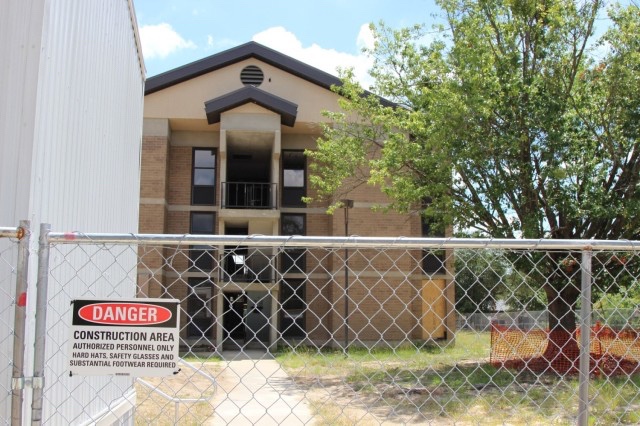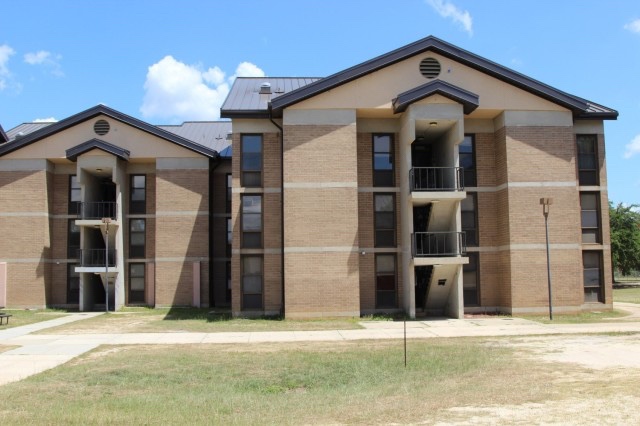
FORT BRAGG, N.C. — The Department of Defense awarded two contracts totaling over $36 million for renovations, repairs and revitalizations to barracks on Fort Bragg Sept. 28, with a future contract for demolitions still pending.
These contracts are part of the accelerated approved funding and will focus on the VOLAR-style barracks, built in the 1970s, that were identified as unsustainable back in early August.
At that time, leadership made the decision to do an early removal of Soldiers from the Smoke Bomb Hill Barracks that were slated for future demolition and renovations. This decision started a multi-week endeavor to relocate the over 1,100 Soldiers.
“When we started the process, it was kind of like doing a jigsaw puzzle with none of the pieces having a picture,” explained Brian Adkins, the Fort Bragg Directorate of Plans, Training, Mobilization and Security director. “We had over a 1,000 of pieces and no idea what the picture was supposed to look like. We had to come together with a plan to move the over 1,000 Soldiers from the affected barracks.”
The team, consisting of housing, engineering, legal, finance, maintenance, transportation, and multiple military units, met twice a day to provide updates to the process and present any issues they may have run into.
“It was a very coordinated process in which housing was intimately involved,” said Adkins. “Just for clarity, our teams are not experts for this sort of movement, but what we are good at is coordinating, synchronizing, and integrating everyone’s efforts. We continue to refine every day on where we are at, making sure to understand the full scope of it, and then trying to balance it. I mean, it really entailed not only Smoke Bomb Hill Soldiers, but every other unit on the post.”
Adkins said Fort Bragg had to consolidate service members to make space for those affected by the degradation of the volar-style barracks.
“We didn’t want to put one Soldier here, one Soldier there,” explained Adkins. “We wanted to maintain some degree of unit integrity, at least at the squad level or above.”
Adding to the challenge of keeping unit integrity, service members also have a day job – missions to accomplish and training to complete.
“In many cases, they still had deployments and we were wedging this in in the middle of that,” added Adkins. “So, it was just an enormous number of moving pieces that we normally didn’t have.”
As the power projection platform, Fort Bragg is ready to deploy at a moment’s notice and has multiple procedures already in place for rapid Soldier movement. These movements are basic muscle memory for the units and the supporting Department of Army civilians; however, this large-scale movement was a first for the installation.
But the Smoke Bomb Hill Barracks situation is more of a challenge because it is not muscle memory and involves several units include U.S. Army Special Operations Command, XVIII Airborne Corps, 20th Engineers, and Medical Command. In all actuality, all major commands on the installation were impacted as service members consolidated to make room for the service members on Smoke Bomb Hill.

Through teamwork, the units and organizations involved created a deliberate plan and a coordinated approach to tackle the barracks issue. The garrison continues to work with Soldiers in helping with the relocation from transportation, the movement of household goods to additional financial support.
In addition to the movement piece, the transportation office added stops to the free Fort Bragg Shuttle Service ensuring affected service members are able to get around post and to their areas of operations.
Adding to Adkin’s analogy of the jigsaw puzzle, the outline of the puzzle is set and now Fort Bragg is able to support the required transportation and financial assistance to fill in the big picture.
“It is our utmost responsibility to ensure [living areas for our service members] are clean, safe and functional,” said Command Sgt. Maj. Thomas Holland, XVIII Airborne Corps commanding sergeant major. “The means of how Soldiers were able to report issues are just as old, if not older, than the barracks themselves. They really didn’t have the space or ways to communicate issues to anyone other than their local chain of command on what they’re seeing in their barracks as frequently or intensively as they needed to.”
Holland added that many service members may feel nervous or fearful of talking with senior leaders but understands that each voice matters and can lead to better solutions. If there is an issue with their living or working facilities, work orders need to be submitted through the Army Maintenance website and the Fort Bragg Directorate of Public Works housing phone line, 910-396-0321.
“The culture of the XVIII Airborne Corps is the spirit of innovation — we know there is an idea trapped somewhere in that squad,” said Holland. “In this case there is an experience, a perspective, trapped in every squad within the Fort Bragg community and we want to untap that perspective as fast as possible so that we can get the appropriate resources to that Soldier — that is our ultimate goal.”
Those resources begin with the approved $105 million for fiscal year 2022 to renovate five Smoke Bomb Hill Barracks and $18 million to demolish 11 barracks from the same area, along with around 100 other facilities on Fort Bragg. Another $29 million has been set aside for other barracks around the installation.
“The Savannah District is leveraging the expertise of the entire USACE enterprise, to include Huntsville and Omaha Districts, to support Fort Bragg’s urgent effort to address the concerns at the Smoke Bomb Hill barracks complex,” said Col. Joseph Geary, U.S. Army Corps of Engineers, Savannah District, commander. “In coordination with the installation, we provide the technical expertise and rapid contracting capability to build the quality facilities that our Soldiers expect and deserve.”
The Army has since published an Execution Order in the beginning of October directing Army senior leaders to conduct comprehensive assessments of all facilities worldwide, with an emphasis on Soldier barracks as key to the overall infrastructure. Army units will physically inspect all barracks rooms, focusing on mold and assessing any other health, safety or functionality issues that require immediate correction.
This effort is directed in preparation for the upcoming Facility Investment Plan wargame and will incorporate facility walk-throughs to validate senior leader requirements with eyes-on knowledge and understanding of needs.
The Army will then develop a comprehensive strategy for planning, programming, and addressing long-term concerns. The FIP is the Army’s planning method for identifying, analyzing, and prioritizing Army facilities investment requirements across a 10-year horizon.
The Army and its leaders will holistically address everywhere service members, civilians, and their Families work, live and train. The Army will ensure a healthy living environment for all service members eliminating any issues that are adversely affecting readiness, resilience, and quality of life.


We’re these barracks Facelifted at some point since the 70’s? They don’t look that old design wise and I swear I remember a time in the 80-90’s where there were no barracks that looked like these. I think back to the old Division Barracks that looked so terrible along Gruber and Ardennes but they were totally different styles. Did they just make these over on the exterior and I thought they were new buildings?
Renovations and new pitched roofs were added sometime around 2000-ish I believe. But in general the exteriors are unchanged
I lived on Smoke Bomb Hill in these barracks 83-87 (across from the “Stab-n-Jab” [Yatima Club]), and my unit used identical barrack at Ft Campbell 93-96 (1st Bde)
I think they were rennovated in the late 90’s -early 2000’s timeframe.
*PLFing from third floor onto barracks mattress flashbacks intensifies*
I remember being moved into these already vacant and condemned barracks in 2017 when I was assigned to 3POB. Took a soldier writing to the Fayetteville Congressman to get anything done about the mold situation in these barracks were shuffled around rooms that didn’t have mold until deployment, and the soldiers that weren’t on that cycle had the lovely duty of cleaning the barracks before moving back into the PsyOp 4 stack. Five years later something is finally being done.
*We were shuffled